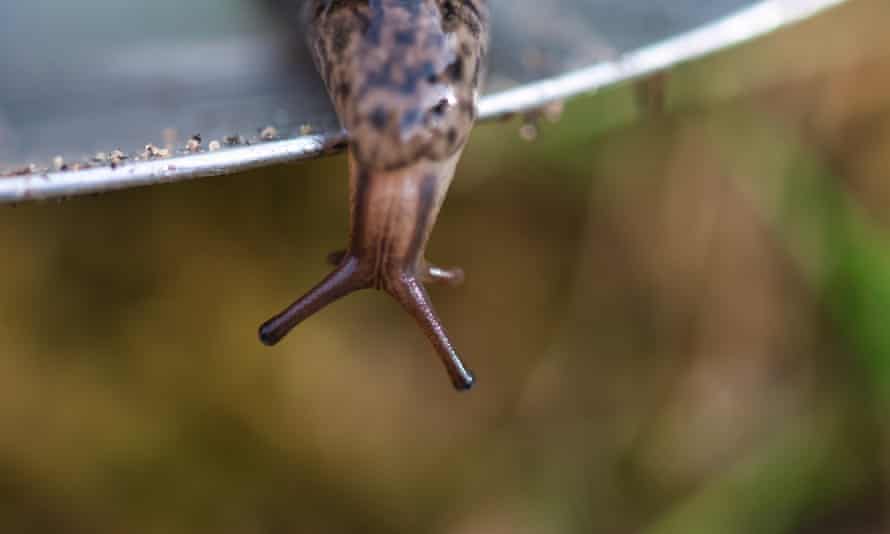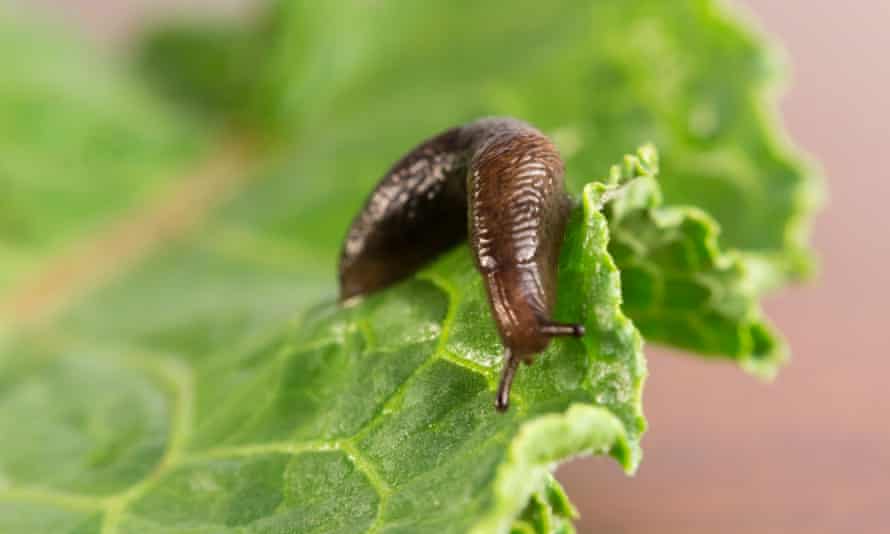If there is anything likely to send even the most mild-mannered gardener on a murderous rampage, it is waking one morning to find the lettuce has been shredded and the carefully nurtured young plants have been razed overnight. In the past few weeks, the slugs and snails have risen – and they are hungry. It’s not that there are more than usual this year – experts don’t think that’s the case – but after a cold and dry April, perhaps the ones that are emerging are doing so with a vengeance and heading for the hostas. Go out at dusk with a torch, particularly if it has been raining. “It’s quite shocking what you find sometimes,” says Charles Dowding, an organic gardener and author. “You suddenly see these swarms of slugs everywhere.”
It is tempting to view gastropods as the enemy, and to start a war that can include search and destroy techniques alongside biological weapons and traps. Less extreme options include gently relocating them, or surrounding their victims with protective barriers. But what is clear is that for most gardeners doing nothing is not an option: in its annual pest ranking, the Royal Horticultural Society (RHS) found that slugs and snails were again gardeners’ biggest foe, after sliding down the chart in recent years.
But before you scatter the slug pellets too liberally, it is worth remembering that only eight or nine of the more than 40 slug species in the UK are a nuisance; of the 100 or so types of snail, “probably only three of them are problematic in gardens,” says Hayley Jones, an entomologist and the slug and snail expert at the RHS. “The others either don’t do much damage, or they eat other things like algae or fungi.” Some slugs and snails can be beneficial “because they eat rotting material so they’re all part of the recycling process in the garden. They all get tarred with the same brush, but they are much more interesting than that.”

They come in different patterns and colours, have thousands of teeth and their slime is a non-Newtonian fluid (its viscosity changes under pressure), which has been researched for medical uses, such as surgical glue. A whole load of TikTok users got very excited earlier this year when one posted a video of two leopard slugs mating – sexily, it involves hanging upside down by a string of mucus and entwining their giant blue penises (slugs are hermaphrodites, having male and female sex organs), which emerge from their heads. Curious sex life aside, leopard slugs – they are brown or grey with dark spots – prefer to eat fungi and rotting matter, and are a good thing to have in your garden. “The leopard slug is very territorial, which is where its reputation for being a cannibal comes from,” says Jones. “It doesn’t actually eat other slugs, but it will attack them for encroaching on its territory.” It may therefore actually help to protect your plants by acting as a guard slug.
If you use pellets or traps you can indiscriminately kill creatures that wouldn’t have bothered your darling dahlias in the first place. “People often measure success by the number of dead bodies and that’s not necessarily very informative,” says Jones of methods such as the beer trap – a sunken bowl of beer, which attracts and drowns slugs: “There is quite a lot of science being done on bait in terms of beer and yeast, but they only really measure how many slugs you catch, rather than how undamaged the plants were as a result.”
Jones says the common garden snail – the one with the brown shell – is probably the most pernicious of snails, and the main slug to watch out for is the netted field species. “They are about 4cm when they’re fully grown but for a lot of the year, they’re way smaller than that. They’re a grey beige colour, with darker speckles over the skin. If you go rummaging around in the leaf litter or underneath plants that have got holes in them, you’ll probably find them. They’re also the ones that you find inside the heads of your lettuce.”
The best way to ensure you find the guilty ones is to catch them in the act. The garden designer and TV presenter Flo Headlam calls it going on “an evening patrol, particularly after it’s rained”. The question then is what to do with them. Headlam tends to put them in the bin or takes them to the park.

Previous surveys for the RHS have found that a fifth of gardeners admit to throwing snails over the fence (Londoners being the worst offenders), and one study found moving them at least 20 metres away from prized plants prevented their homing instinct. Saul Walker, the head gardener at Stonelands House in Devon and host of the gardening podcast Talking Heads, collects them from plants, under and around pots, and the greenhouse, then moves them, although, he points out, he does have the benefit of 25 hectares (60 acres). “I throw them in the woodland. They don’t make their way back, I don’t think.”
The garden designer Cleve West relocates “them to another part of the allotment, or somewhere they’re not going to damage what we’re growing. Not everyone’s going to have that luxury, but do what you can because we’re in such a biodiversity crisis, all forms of wildlife should be respected.” I’ve often taken tubs filled with slugs and snails to the park and released them, but Jones advises not to do this. “Lots of the slugs that you find in the UK aren’t actually native species, so if you take them to a wild area, you might actually be introducing a non-native slug that wasn’t there before,” she says. She suggests moving them to a compost heap. “Encourage them to eat the rotting stuff rather than your favourite plants.” But won’t your compost be full of slugs’ eggs? “I don’t think that’s going to push the slug numbers up any more than it would them laying eggs anywhere else,” she says. So you may as well put them to work while they’re at it.
If you want to outsource the cull, Jones says nematodes – microscopic parasites that release bacteria into the slug’s body – are effective, but they require a bit of effort and are expensive (they also only affect slugs, not snails, as they work underground). Slug pellets containing metaldehyde are harmful to other wildlife, and will be phased out by next year, but the RHS has found that organic pellets work almost as well.
Once you’ve collected the offenders over a few nights and reduced the population, you can think about making your garden less hospitable. “For example, I don’t use any mulches of hay or straw, or grass clippings – I only use compost on the beds,” says Dowding. “There’s nowhere for them to hide on a sunny day, so they’re not near plants at night. Keep the edges of the garden tidy. If you have beds with wooden sides, particularly if the wood is starting to decay, that’s an amazing habitat for slugs.” Headlam recommends finding out where their hiding places are. “The classic thing is if you’ve got a pile of bricks or pots or whatever, they tend to congregate there. Move things around, open things up.”
There are numerous barrier techniques such as placing crushed-up eggshells, coffee grounds, grit, sand or salt around the base of the plant in the hope slimy bodies will be repelled, but “there isn’t much evidence for how well they work,” says Jones. In lab studies, copper – which can be wrapped around pots, or in a ring around plants – put slugs and snails off, says Jones, “but they don’t perform so well actually out in the garden. It’s worth trying, but not necessarily spending heaps of money on.” She doesn’t advise making homemade pesticides – steeping garlic in water is a popular one – to spray on the leaves to make them less tasty. “Technically you’re using an unregistered pesticide, so it’s not something we would ever recommend.”
Headlam has had some success with sheep’s wool pellets, which act as a barrier, and she also likes applying petroleum jelly around the sides of pots “because I’ve had more damage to plants in pots than in the ground. It’s a texture they don’t like moving over.”
The question of sacrificial plants – providing favoured food for slugs and snails in the hope they’ll leave the lupins alone – is contentious; Walker and Dowding think it will just encourage them. Another option is to only grow things slugs and snails will ignore, such as geraniums and astrantias, but that feels like giving in. Watering in the morning rather than the evening is thought to help, as it gives the surface of the soil a chance to dry during the day and discourage slugs at night.
All agree the best way to deal with slugs and snails is to approach the garden as a whole and “build up a robust ecosystem” as Walker puts it. “I don’t try to intervene too much, then things will control themselves in some way.” Dowding, who has pioneered his organic, no-digging principle, feels the same. “If you don’t dig the soil, you are not destroying any predators such as beetles. Digging is very destructive of soil life that we don’t normally see or appreciate, and it breaks that whole balance.” Make your garden as wildlife-friendly as possible, says Jones, and you will encourage natural predators such as beetles, frogs and toads (create a pond, however small) and hedgehogs. However, you can’t just leave them to it, she points out. “No more than 10% of a hedgehog’s diet is slugs – they’re never going to make a huge dent.”
The other idea is to grow robust plants, and get them to a decent size before you plant them out. If stronger, bigger plants get nibbled, “they can outgrow it,” says Walker. West advises keeping an eye on the weather forecast and ideally planting out when it’s dry, though he adds this is probably less important when the plants are bigger. With vulnerable seedlings that have been sown directly, he also sows a line of lettuces nearby to distract slugs and snails. “We need to try to get over this idea that we’re the supreme species on this planet and accept the fact that other creatures have a right to enjoy their time on Earth as well. That’s a much more balanced way of looking at it rather than just waging war on everything that moves.”
from Lifestyle | The Guardian https://ift.tt/3oRk5JY
via IFTTT

comment 0 Comment
more_vert